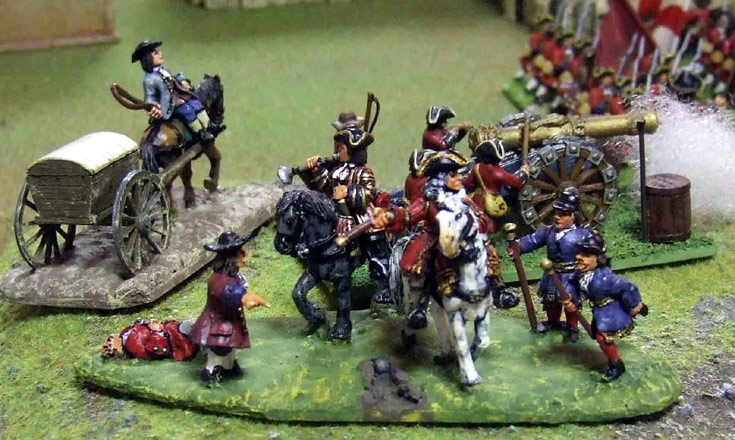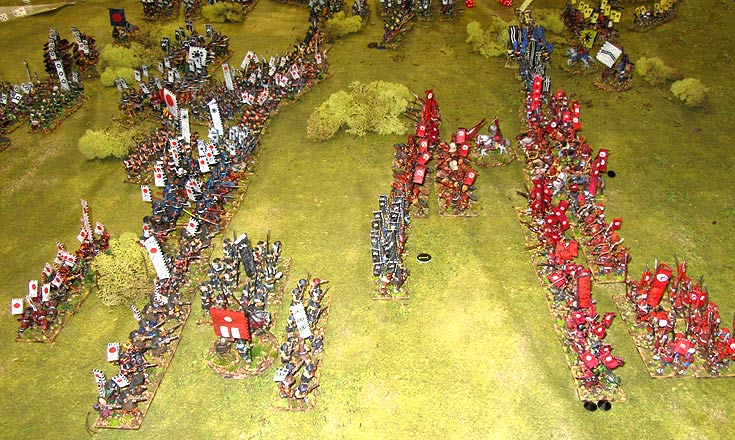
Gavre, 1708
3rd July 2008, Comments Off
Misc., The Marlburian Era, Beneath the Lilly Banners, 28mm
While its nice to get your own toys out, sometimes I appreciate games where I don’t have to bring along hundreds of figures. When someone suggested playing a “Marlburian” game, to try out Beneath the Lilly Banners, then I acquiesced. That’s because other people had whole armies, while I just had three battalions. That’s them marching through the village. Many of the rest were old Minifigs dating from the 1970’s, but the figures have aged better than many of the rest of us, and en-masse they looked the part. This was a straightforward meeting engagement, with both sides lining up on the table edge – a small Franco-Bavarian army on one side, and an Allied force (Dutch, British and Danes) on the other. Actually, Bill Gilchrist (pictured in the lurid mauve stripes) seemed to sneak a couple of units of Russians onto the table, posing as German troops in French service, but nobody seemed to mind. Another novelty was a visit from Peter Tauscher, a German wargamer from Hamburg. That’s Peter in the white shirt. A regular visitor to this site, Peter was on holiday in Edinburgh, and came along to meet us. He seemed a natural commander for the Bavarians! Actually, if like Peter, any of you find yourselves in Edinburgh on a Thursday evening, do please get in touch, and join us. We’ll try to involve you in a game.
This was a straightforward meeting engagement, with both sides lining up on the table edge – a small Franco-Bavarian army on one side, and an Allied force (Dutch, British and Danes) on the other. Actually, Bill Gilchrist (pictured in the lurid mauve stripes) seemed to sneak a couple of units of Russians onto the table, posing as German troops in French service, but nobody seemed to mind. Another novelty was a visit from Peter Tauscher, a German wargamer from Hamburg. That’s Peter in the white shirt. A regular visitor to this site, Peter was on holiday in Edinburgh, and came along to meet us. He seemed a natural commander for the Bavarians! Actually, if like Peter, any of you find yourselves in Edinburgh on a Thursday evening, do please get in touch, and join us. We’ll try to involve you in a game. Both sides advanced to contact, hindered by Barry’s mechanism where only a portion of each force can move if you roll poor movement dice – and we all did. the cavalry on both flanks raced ahead and charged each other – as is their wont – leaving the infantry to plod towards each other.
Both sides advanced to contact, hindered by Barry’s mechanism where only a portion of each force can move if you roll poor movement dice – and we all did. the cavalry on both flanks raced ahead and charged each other – as is their wont – leaving the infantry to plod towards each other. My British and Dutch had occupied a village on the Allied left, and held the buildings against the Bavarian hordes, despite quite atrocious casualties. The British brigade on their right was commanded by a “plodder”, who consistently rolled bad movement dice, so for much of the game my guys were on their own. However, they rest of the British line eventually moved up in support, and the crisis passed.
My British and Dutch had occupied a village on the Allied left, and held the buildings against the Bavarian hordes, despite quite atrocious casualties. The British brigade on their right was commanded by a “plodder”, who consistently rolled bad movement dice, so for much of the game my guys were on their own. However, they rest of the British line eventually moved up in support, and the crisis passed. Little happened in the centre, as the same inertia caused by the dice prevented both sides from doing more than conducting a long range artillery duel. However, the real battle took place on the flanks, where the cavalry were fighting it out. On the left, a squadron of my Danish horse was routed in its first clash, and its supports were charged at the halt by the French cavalry. Amazingly I saved the day by rolling a bucket-load of “6’s”, and over the next few turns the French horse were comprehensively chopped to pieces. The same happened on the Allied right, where Dave O’Brian’s pride and joy unit of Scots and Irish horse routed their French opponents.
Little happened in the centre, as the same inertia caused by the dice prevented both sides from doing more than conducting a long range artillery duel. However, the real battle took place on the flanks, where the cavalry were fighting it out. On the left, a squadron of my Danish horse was routed in its first clash, and its supports were charged at the halt by the French cavalry. Amazingly I saved the day by rolling a bucket-load of “6’s”, and over the next few turns the French horse were comprehensively chopped to pieces. The same happened on the Allied right, where Dave O’Brian’s pride and joy unit of Scots and Irish horse routed their French opponents. At that point the Franco-Bavarian commander decided to withdraw. The only place where his troops still posed a threat was on the Allied left, where his Bavarian grenadiers were in contact with the Allied foot. However, they were isolated, so a general retreat seemed the only sensible course.
At that point the Franco-Bavarian commander decided to withdraw. The only place where his troops still posed a threat was on the Allied left, where his Bavarian grenadiers were in contact with the Allied foot. However, they were isolated, so a general retreat seemed the only sensible course. As for the rules, this was our first game using Beneath the Lilly Banners, so we spent a lot of time poring over them, cursing the writer for not including an index! However, we managed to figure it all out eventually, and the game ran fairly smoothly – and reasonably quickly. Of course, it helped that several of us were familiar with the same rules’ writer’s unpublished “Napoleonic” rules, which use similar mechanisms. they proved a little slow, but still, despite a late start we managed to fight a mid-sized game (about 300 figures a side) to a conclusion in an evening, which is more than I can say we usually achieve using my Seven Years War rules! We’ll try the rules again, and in the meantime I’ll be digging out my unpainted 1690’s lead, in an attempt to increase the size of my own contingent.
As for the rules, this was our first game using Beneath the Lilly Banners, so we spent a lot of time poring over them, cursing the writer for not including an index! However, we managed to figure it all out eventually, and the game ran fairly smoothly – and reasonably quickly. Of course, it helped that several of us were familiar with the same rules’ writer’s unpublished “Napoleonic” rules, which use similar mechanisms. they proved a little slow, but still, despite a late start we managed to fight a mid-sized game (about 300 figures a side) to a conclusion in an evening, which is more than I can say we usually achieve using my Seven Years War rules! We’ll try the rules again, and in the meantime I’ll be digging out my unpainted 1690’s lead, in an attempt to increase the size of my own contingent.




